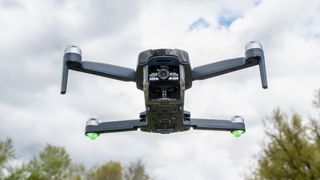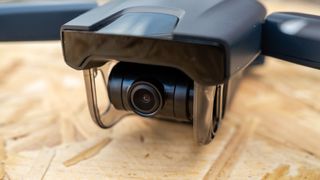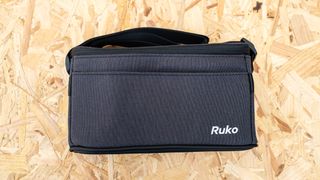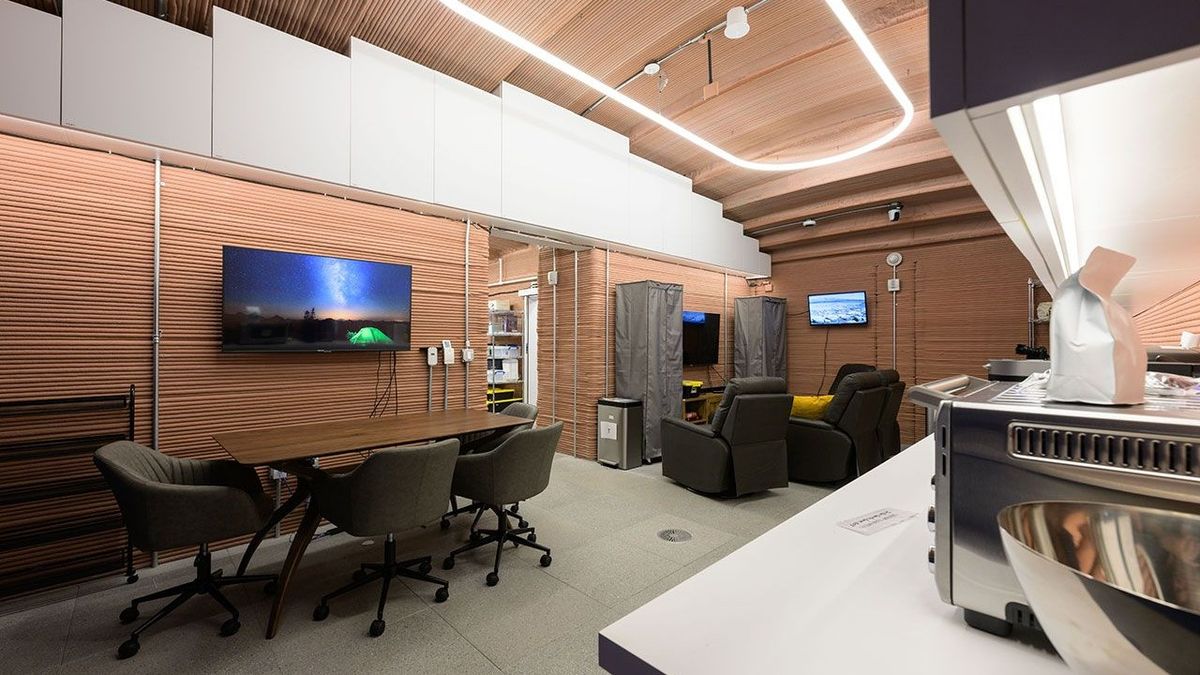Buying your first drone can often be an exercise of overcoming several hurdles: fear of crashing an expensive device, complexity and regulations. A basic drone that addresses all of these is the Ruko F11 Mini, which is an inexpensive sub-350g model offering basic features in an easy-to-use package.
Key Specs
Weight: 8.64 oz / 245 g
Dimensions: 5.90 x 3.34 x 2.16 in / 150 x 85 x 55 mm folded / 11.81 x 8.46x 2.16 in / 300 x 215 x 55 mm unfolded
Battery: 2100 mAh LiPo / up to 30 minutes
Charger type: Micro USB cable
Modes: Normal, Sport
Video transmission range: 1640 ft / 500 m
Video resolution: 4K (3840×2160), 2.7K (2560×1440)
Frame rates: 4K 15 fps / 2.7K 25 fps
Features available include basic subject tracking, point of interest and waypoint flight alongside GPS positioning. But being a low-cost beginner model, more advanced features such as obstacle avoidance and manual camera control are absent. This is pretty much the norm at this end of the scale. It’s certainly not one of the best drones, but it could be one of the best beginner drones in terms of being a model that’s useful for learning flight controls.
The main advantage of the F11 Mini is that it’s inexpensive for a sub-250g drone at just $156 / £200 on Amazon. This makes drone flight alongside aerial photography and video accessible to more people and also means that you don’t have to have a huge budget to get started. Of course, you have to make some concessions at this level, particularly in the area of image quality, but this is to be expected for the low price.
Despite the low price, the F11 Mini comes in a kit with everything you need to fly, including two batteries which is great. Quite often, less expensive drones only come with a single battery which severely limits flight times when you’re out for the day. However, with any drone where the batteries are charged directly via USB cable, including the F11 Mini, you can easily charge on the go using a USB power bank.
Ruko F11 Mini review
Ruko F11 Mini review: Design
- Sub-250g folding design
- 2-axis gimbal
- Basic controller
The F11 Mini is a sub-250g drone, so it’s compact and lightweight with a folded size of 5.90 x 3.34 x 2.16 in / 150 x 85 x 55 mm, which extends to 11.81 x 8.46x 2.16 in / 300 x 215 x 55 mm when unfolded. The weight comes in at 8.64oz / 245g. This makes it regulator-friendly and US users won’t need to register the drone with the FAA and it doesn’t need a remote ID, although UK users will have to register with the CAA and display their Operator ID on the drone.
The build quality of this palm-sized drone, when folded, isn’t as high as more expensive models but it’s fine and there’s even a protector to the sides of the gimbal that would protect the camera in the event of a crash. The gimbal itself is only 2-axis, so you can only tilt it up and down to adjust the camera angle, with no mechanical or Electronic Image Stabilization (EIS).
The controller is basic but offers all of the controls you need including buttons to adjust the tilt of the gimbal, photo and video capture buttons, a take-off/landing button and a Return to Home button among a few others. The phone holder lifts from the front and can accommodate both smaller and larger smartphones, and two grips extend from the bottom of the controller to make it more comfortable to hold. It’s far from the most robust feeling drone controller, but perfectly adequate for its intended purpose.
The connection between the phone and the drone for app use and to view the camera feed is via the drone’s Wi-Fi, so no cables are needed which keeps things simple. But you do have to switch off mobile data on the phone to avoid a blank screen and also manually pair the controller and drone each time you fly or change the battery. This is achieved by pushing the left control stick up until you hear a beep, and then down until you hear a beep.
Ruko F11 Mini review: Functionality

- Basic automated flight features
- GPS positioning
- Impressive battery life
When it comes to flight, the F11 Mini flies well and uses GPS positioning to maintain position and a downward optical flow sensor for indoor flight. There is some drift when hovering outdoors and connected to GPS, but this isn’t a problem because it’s only minor. GPS, in turn, brings Return to Home functionality, which is where the drone will fly back if the connection to the controller is lost, when the battery reaches 20% or when initiated by the pilot.
Battery life is advertised at up to 30 minutes, and during testing in 20 mph wind gusts the F11 Mini achieved an impressive 21 minutes of flight before Return to Home was automatically initiated at 20% battery.
In this wind, the drone struggled, so it’s much more suited to low-wind situations where the battery would naturally provide longer flight times. Flight modes available include Normal and Sport, with the latter providing more speed and power but also using more battery power.
GPS Follow, Waypoint/route planning and Point of Interest are three automated flight modes alongside a Split Screen capture option for creating virtual reality videos. These all work, but there’s no real finesse here so results are much less impressive than with more expensive drone models. Plus, with no obstacle avoidance, you have to be flying in an open area where there’s no chance of a collision with an obstacle.
Ruko F11 Mini review: Performance
- Unimpressive image quality
- No Image Stabilization
- Point-and-shoot camera
There’s no getting away from the fact the F11 Mini’s camera is basic in terms of control, with point-and-shoot only, and unimpressive image quality for both photos and videos. Exact camera specs are a little thin on the ground but photos come in at 12.5MP and you can capture video in 4K at 15 fps and 2.7K at 25 fps. The latter will provide smoother results in terms of frame rate, but with 4K being the standard video resolution these days, it’s a shame that the 4K frame rate is so low.
Overall, image quality is slightly better than that of a toy camera, with fixed focus and heavy processing diminishing detail. The most significant shortfall, especially for video, is the absence of any kind of Image Stabilization.

This means that alongside the FPV look where the camera captures the pitch and roll of the drone in photos and videos, videos are shaky because every drone movement is captured in videos and this is exacerbated in windy conditions.
An FPV style of video capture is always present in drones that don’t have a 3-axis gimbal, which handles movement, but the lack of even Electronic Image Stabilization results in extremely rough and ready video footage.
Couple this with jello, which is image wobble from the electronic shutter, and the video quality isn’t great overall. Then there’s the pitch change of the drone as it flies forwards or backwards, which can make it difficult to compose videos correctly because you have to guestimate the camera angle to account for the pitch change beforehand.
Ruko F11 Mini review: Cost

The Ruko F11 Mini is a fairly inexpensive beginner drone, priced at $156 / £200 on Amazon. The kit includes everything you need: the F11 Mini drone, a controller, two batteries, two Micro USB cables, a spare set of propellers, a screwdriver and a carry bag.
Setup is easy enough, but you do have to connect the controller and drone manually each time you fly, change the battery, and turn off mobile data on your phone to avoid Wi-Fi connection issues.
The included carry bag comfortably accommodates the whole kit when out flying, which isn’t always the case with drones. Plus, there’s enough space in the bag to carry a small USB power bank that could be used to charge the drone batteries and controller on location.
Should you buy the Ruko F11 Mini?
If you’re a beginner on a tight budget, the F11 Mini could provide an entry point into drone flight before purchasing a more expensive and advanced model. As a flight-learning drone, it’s a good option and with some drift when hovering, when you move onto a more advanced model you’ll find it incredibly easy to fly in comparison.
If your aim is, however, to also have a drone capable of capturing high-quality photos and videos, this isn’t one of the F11 Mini’s strengths. With no Image Stabilization, mechanical or electronic, video has a shaky, rough-and-ready appearance that may appeal to some people, but overall image quality for both photos and videos is lacking.
If the Ruko F11 Mini isn’t for you
If you’re looking for an affordable beginner drone that can capture decent photos and videos, the Potensic Atom SE is a great option to consider. This drone offers Electronic Image Stabilisation so 4K footage is smoothed, but still exhibits the FPV look where the tilt of the drone is captured. Image quality is good, and it can even capture Photos in Raw and JPEG formats.
For those with a bigger budget, the DJI Mini 3 is the best sub-250g beginner drone available, offering the most reliable features and the best image quality for its price. This drone can capture video and photos in both landscape and portrait (upright) formats, which is useful for people who upload their drone shots to social media.
If you’re looking for something a little different, the DJI Avata 2 is the most expensive model to be recommended here, but it’s also one of the easiest FPV drones to fly thanks to the intuitive Motion Controller that can be used to control it. If you’re an FPV beginner hoping to capture immersive FPV video, this could be the drone for you.




